Entrepreneurship: Examining Factors Affecting Women-Owned Startups
VerifiedAdded on 2023/06/15
|10
|3690
|187
Essay
AI Summary
This essay explores the reasons why women are less likely to start businesses compared to men, despite often having equal potential. It examines factors such as lack of confidence in risk-taking, underrepresentation in executive roles, limited access to financial resources and training, and gender discrimination in credit granting. The essay also discusses the impact of social perceptions, the importance of persistence, and the role of exit strategies in entrepreneurship. While noting a recent increase in female entrepreneurship globally, the analysis emphasizes the need for policy changes and institutional support to promote women's entrepreneurial skills, strengthen their networks, and ensure access to funding. The essay concludes by highlighting the potential of women entrepreneurs as drivers of economic growth and development, particularly in developing economies, and the importance of addressing gender bias in corporate structures to foster their advancement.
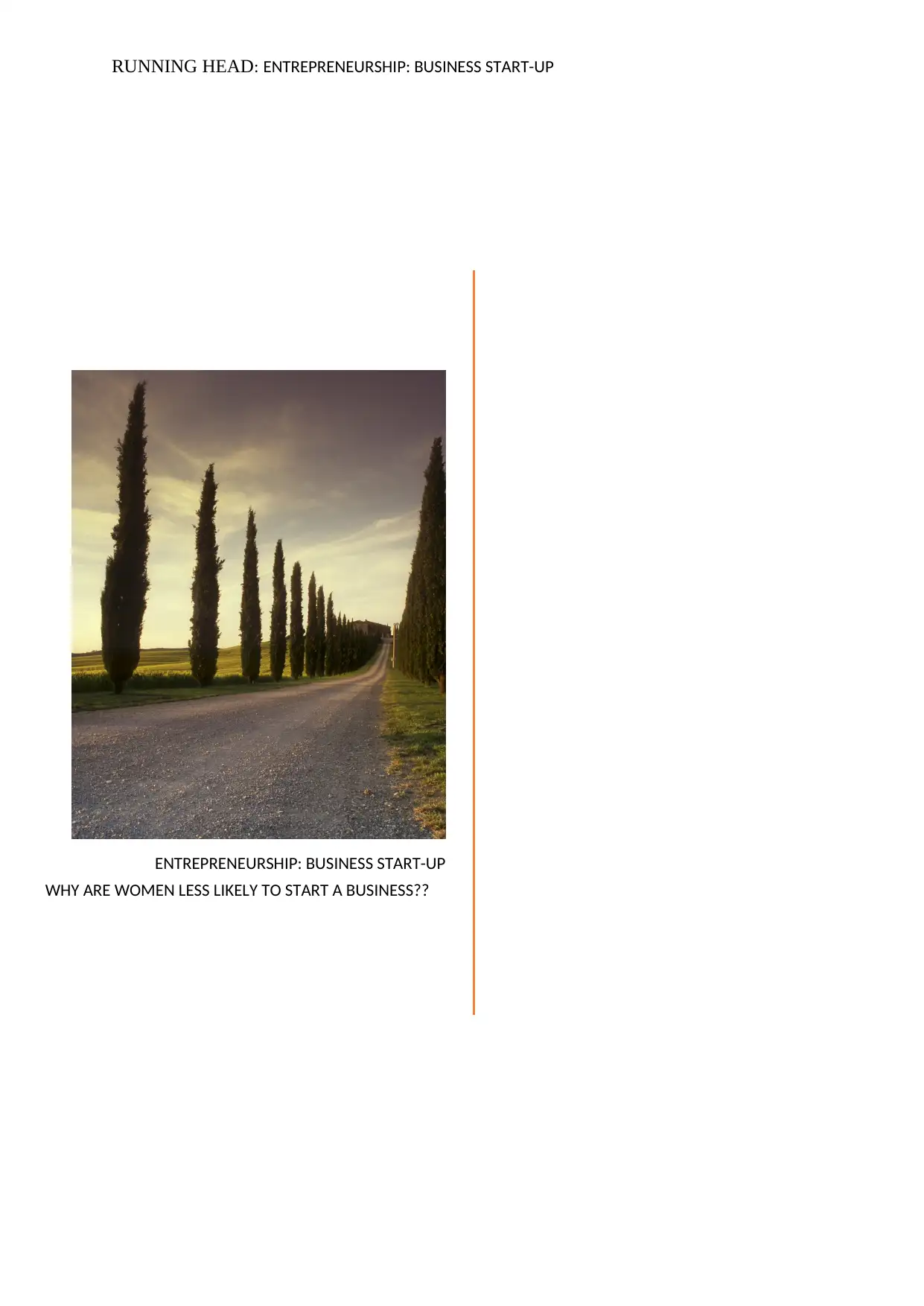
RUNNING HEAD: ENTREPRENEURSHIP: BUSINESS START-UP
ENTREPRENEURSHIP: BUSINESS START-UP
WHY ARE WOMEN LESS LIKELY TO START A BUSINESS??
ENTREPRENEURSHIP: BUSINESS START-UP
WHY ARE WOMEN LESS LIKELY TO START A BUSINESS??
Paraphrase This Document
Need a fresh take? Get an instant paraphrase of this document with our AI Paraphraser
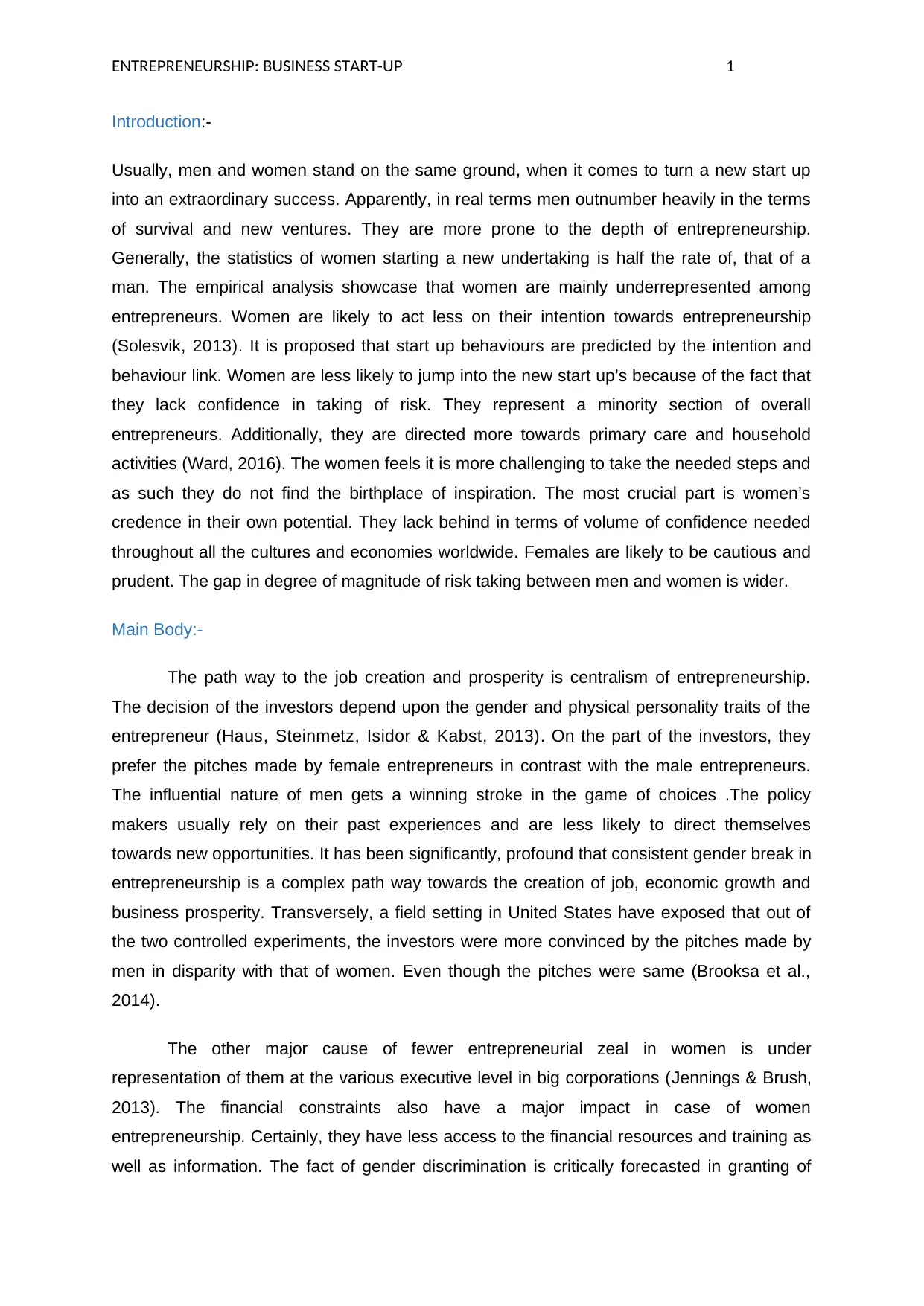
ENTREPRENEURSHIP: BUSINESS START-UP 1
Introduction:-
Usually, men and women stand on the same ground, when it comes to turn a new start up
into an extraordinary success. Apparently, in real terms men outnumber heavily in the terms
of survival and new ventures. They are more prone to the depth of entrepreneurship.
Generally, the statistics of women starting a new undertaking is half the rate of, that of a
man. The empirical analysis showcase that women are mainly underrepresented among
entrepreneurs. Women are likely to act less on their intention towards entrepreneurship
(Solesvik, 2013). It is proposed that start up behaviours are predicted by the intention and
behaviour link. Women are less likely to jump into the new start up’s because of the fact that
they lack confidence in taking of risk. They represent a minority section of overall
entrepreneurs. Additionally, they are directed more towards primary care and household
activities (Ward, 2016). The women feels it is more challenging to take the needed steps and
as such they do not find the birthplace of inspiration. The most crucial part is women’s
credence in their own potential. They lack behind in terms of volume of confidence needed
throughout all the cultures and economies worldwide. Females are likely to be cautious and
prudent. The gap in degree of magnitude of risk taking between men and women is wider.
Main Body:-
The path way to the job creation and prosperity is centralism of entrepreneurship.
The decision of the investors depend upon the gender and physical personality traits of the
entrepreneur (Haus, Steinmetz, Isidor & Kabst, 2013). On the part of the investors, they
prefer the pitches made by female entrepreneurs in contrast with the male entrepreneurs.
The influential nature of men gets a winning stroke in the game of choices .The policy
makers usually rely on their past experiences and are less likely to direct themselves
towards new opportunities. It has been significantly, profound that consistent gender break in
entrepreneurship is a complex path way towards the creation of job, economic growth and
business prosperity. Transversely, a field setting in United States have exposed that out of
the two controlled experiments, the investors were more convinced by the pitches made by
men in disparity with that of women. Even though the pitches were same (Brooksa et al.,
2014).
The other major cause of fewer entrepreneurial zeal in women is under
representation of them at the various executive level in big corporations (Jennings & Brush,
2013). The financial constraints also have a major impact in case of women
entrepreneurship. Certainly, they have less access to the financial resources and training as
well as information. The fact of gender discrimination is critically forecasted in granting of
Introduction:-
Usually, men and women stand on the same ground, when it comes to turn a new start up
into an extraordinary success. Apparently, in real terms men outnumber heavily in the terms
of survival and new ventures. They are more prone to the depth of entrepreneurship.
Generally, the statistics of women starting a new undertaking is half the rate of, that of a
man. The empirical analysis showcase that women are mainly underrepresented among
entrepreneurs. Women are likely to act less on their intention towards entrepreneurship
(Solesvik, 2013). It is proposed that start up behaviours are predicted by the intention and
behaviour link. Women are less likely to jump into the new start up’s because of the fact that
they lack confidence in taking of risk. They represent a minority section of overall
entrepreneurs. Additionally, they are directed more towards primary care and household
activities (Ward, 2016). The women feels it is more challenging to take the needed steps and
as such they do not find the birthplace of inspiration. The most crucial part is women’s
credence in their own potential. They lack behind in terms of volume of confidence needed
throughout all the cultures and economies worldwide. Females are likely to be cautious and
prudent. The gap in degree of magnitude of risk taking between men and women is wider.
Main Body:-
The path way to the job creation and prosperity is centralism of entrepreneurship.
The decision of the investors depend upon the gender and physical personality traits of the
entrepreneur (Haus, Steinmetz, Isidor & Kabst, 2013). On the part of the investors, they
prefer the pitches made by female entrepreneurs in contrast with the male entrepreneurs.
The influential nature of men gets a winning stroke in the game of choices .The policy
makers usually rely on their past experiences and are less likely to direct themselves
towards new opportunities. It has been significantly, profound that consistent gender break in
entrepreneurship is a complex path way towards the creation of job, economic growth and
business prosperity. Transversely, a field setting in United States have exposed that out of
the two controlled experiments, the investors were more convinced by the pitches made by
men in disparity with that of women. Even though the pitches were same (Brooksa et al.,
2014).
The other major cause of fewer entrepreneurial zeal in women is under
representation of them at the various executive level in big corporations (Jennings & Brush,
2013). The financial constraints also have a major impact in case of women
entrepreneurship. Certainly, they have less access to the financial resources and training as
well as information. The fact of gender discrimination is critically forecasted in granting of
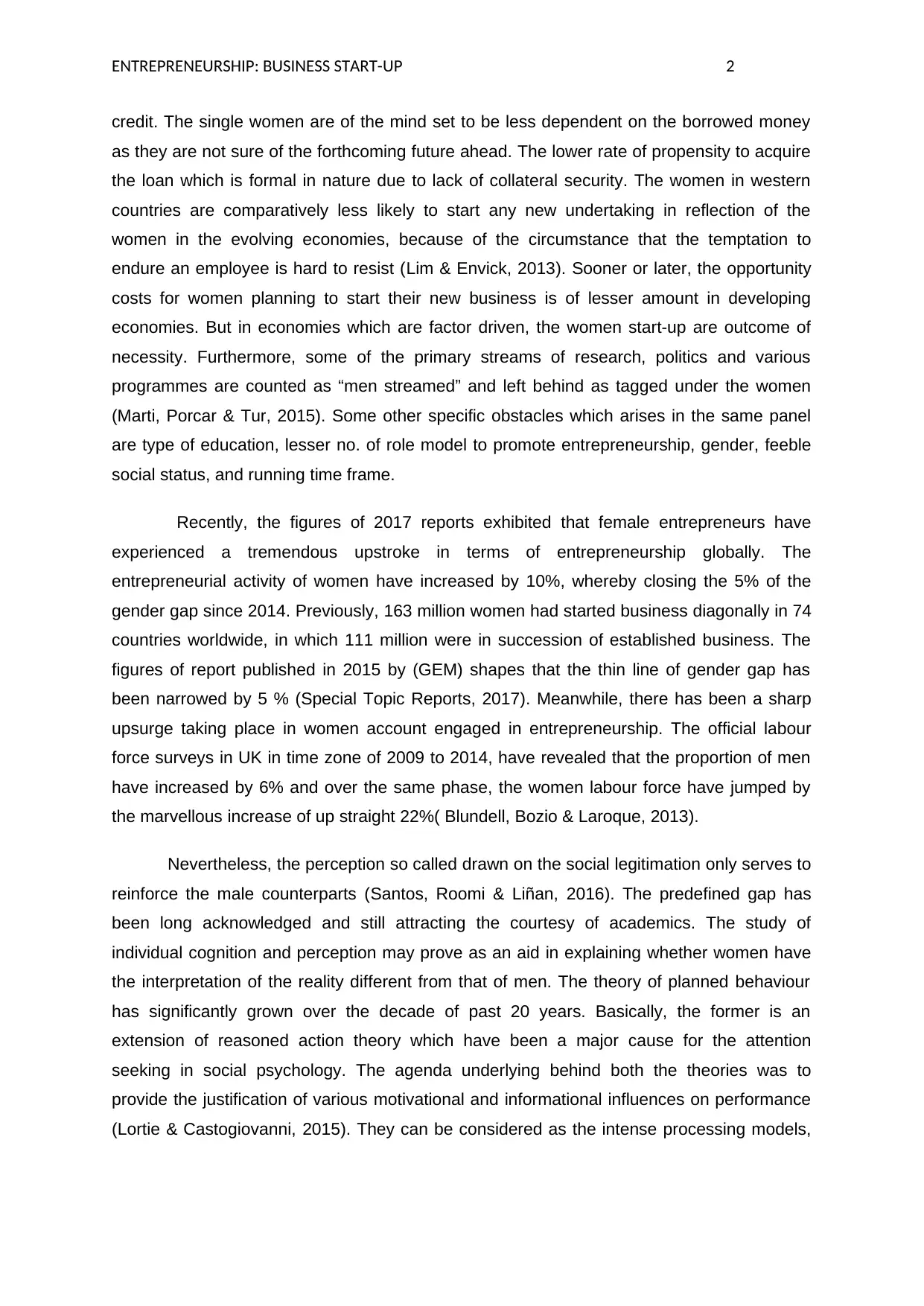
ENTREPRENEURSHIP: BUSINESS START-UP 2
credit. The single women are of the mind set to be less dependent on the borrowed money
as they are not sure of the forthcoming future ahead. The lower rate of propensity to acquire
the loan which is formal in nature due to lack of collateral security. The women in western
countries are comparatively less likely to start any new undertaking in reflection of the
women in the evolving economies, because of the circumstance that the temptation to
endure an employee is hard to resist (Lim & Envick, 2013). Sooner or later, the opportunity
costs for women planning to start their new business is of lesser amount in developing
economies. But in economies which are factor driven, the women start-up are outcome of
necessity. Furthermore, some of the primary streams of research, politics and various
programmes are counted as “men streamed” and left behind as tagged under the women
(Marti, Porcar & Tur, 2015). Some other specific obstacles which arises in the same panel
are type of education, lesser no. of role model to promote entrepreneurship, gender, feeble
social status, and running time frame.
Recently, the figures of 2017 reports exhibited that female entrepreneurs have
experienced a tremendous upstroke in terms of entrepreneurship globally. The
entrepreneurial activity of women have increased by 10%, whereby closing the 5% of the
gender gap since 2014. Previously, 163 million women had started business diagonally in 74
countries worldwide, in which 111 million were in succession of established business. The
figures of report published in 2015 by (GEM) shapes that the thin line of gender gap has
been narrowed by 5 % (Special Topic Reports, 2017). Meanwhile, there has been a sharp
upsurge taking place in women account engaged in entrepreneurship. The official labour
force surveys in UK in time zone of 2009 to 2014, have revealed that the proportion of men
have increased by 6% and over the same phase, the women labour force have jumped by
the marvellous increase of up straight 22%( Blundell, Bozio & Laroque, 2013).
Nevertheless, the perception so called drawn on the social legitimation only serves to
reinforce the male counterparts (Santos, Roomi & Liñan, 2016). The predefined gap has
been long acknowledged and still attracting the courtesy of academics. The study of
individual cognition and perception may prove as an aid in explaining whether women have
the interpretation of the reality different from that of men. The theory of planned behaviour
has significantly grown over the decade of past 20 years. Basically, the former is an
extension of reasoned action theory which have been a major cause for the attention
seeking in social psychology. The agenda underlying behind both the theories was to
provide the justification of various motivational and informational influences on performance
(Lortie & Castogiovanni, 2015). They can be considered as the intense processing models,
credit. The single women are of the mind set to be less dependent on the borrowed money
as they are not sure of the forthcoming future ahead. The lower rate of propensity to acquire
the loan which is formal in nature due to lack of collateral security. The women in western
countries are comparatively less likely to start any new undertaking in reflection of the
women in the evolving economies, because of the circumstance that the temptation to
endure an employee is hard to resist (Lim & Envick, 2013). Sooner or later, the opportunity
costs for women planning to start their new business is of lesser amount in developing
economies. But in economies which are factor driven, the women start-up are outcome of
necessity. Furthermore, some of the primary streams of research, politics and various
programmes are counted as “men streamed” and left behind as tagged under the women
(Marti, Porcar & Tur, 2015). Some other specific obstacles which arises in the same panel
are type of education, lesser no. of role model to promote entrepreneurship, gender, feeble
social status, and running time frame.
Recently, the figures of 2017 reports exhibited that female entrepreneurs have
experienced a tremendous upstroke in terms of entrepreneurship globally. The
entrepreneurial activity of women have increased by 10%, whereby closing the 5% of the
gender gap since 2014. Previously, 163 million women had started business diagonally in 74
countries worldwide, in which 111 million were in succession of established business. The
figures of report published in 2015 by (GEM) shapes that the thin line of gender gap has
been narrowed by 5 % (Special Topic Reports, 2017). Meanwhile, there has been a sharp
upsurge taking place in women account engaged in entrepreneurship. The official labour
force surveys in UK in time zone of 2009 to 2014, have revealed that the proportion of men
have increased by 6% and over the same phase, the women labour force have jumped by
the marvellous increase of up straight 22%( Blundell, Bozio & Laroque, 2013).
Nevertheless, the perception so called drawn on the social legitimation only serves to
reinforce the male counterparts (Santos, Roomi & Liñan, 2016). The predefined gap has
been long acknowledged and still attracting the courtesy of academics. The study of
individual cognition and perception may prove as an aid in explaining whether women have
the interpretation of the reality different from that of men. The theory of planned behaviour
has significantly grown over the decade of past 20 years. Basically, the former is an
extension of reasoned action theory which have been a major cause for the attention
seeking in social psychology. The agenda underlying behind both the theories was to
provide the justification of various motivational and informational influences on performance
(Lortie & Castogiovanni, 2015). They can be considered as the intense processing models,
⊘ This is a preview!⊘
Do you want full access?
Subscribe today to unlock all pages.

Trusted by 1+ million students worldwide
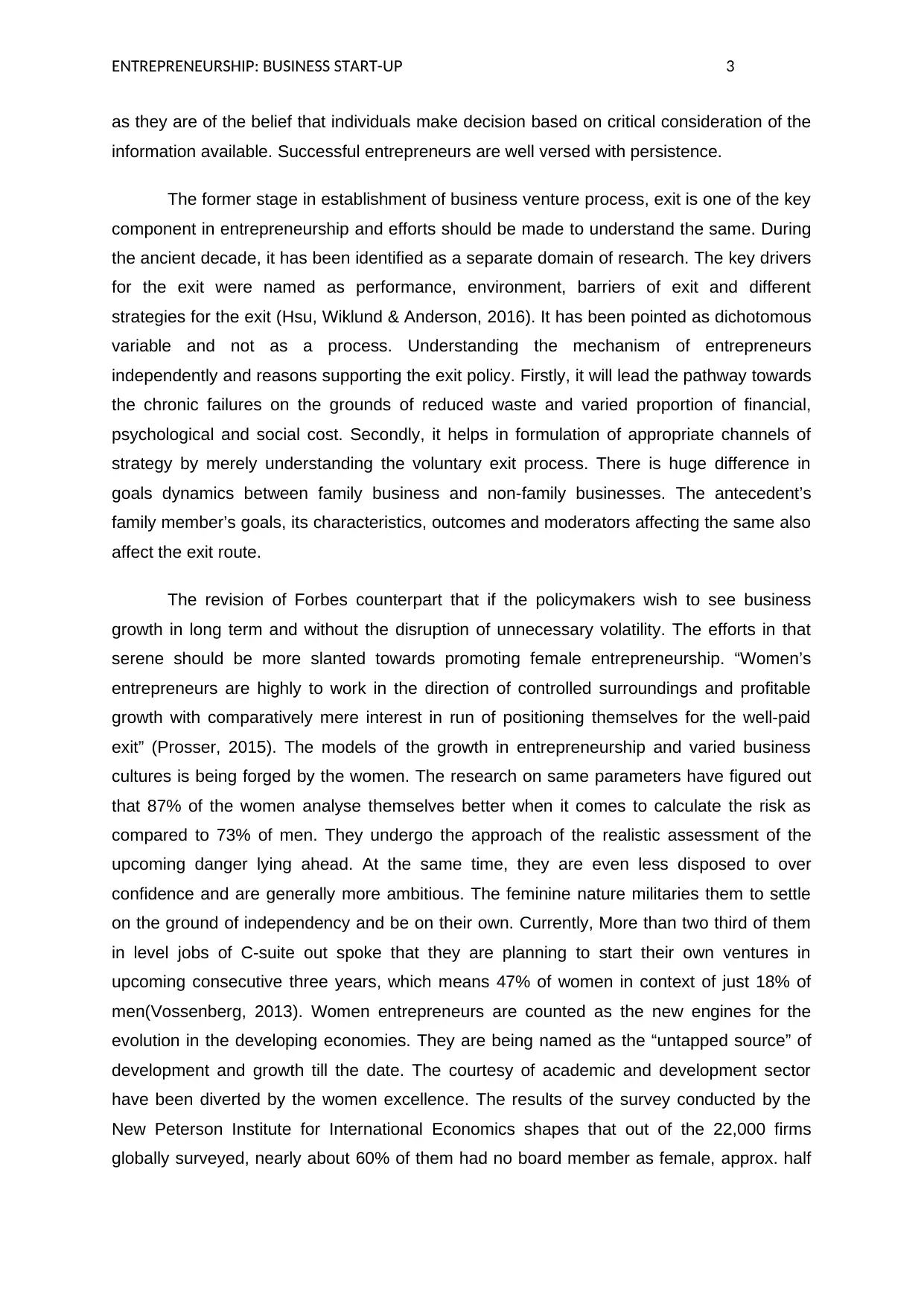
ENTREPRENEURSHIP: BUSINESS START-UP 3
as they are of the belief that individuals make decision based on critical consideration of the
information available. Successful entrepreneurs are well versed with persistence.
The former stage in establishment of business venture process, exit is one of the key
component in entrepreneurship and efforts should be made to understand the same. During
the ancient decade, it has been identified as a separate domain of research. The key drivers
for the exit were named as performance, environment, barriers of exit and different
strategies for the exit (Hsu, Wiklund & Anderson, 2016). It has been pointed as dichotomous
variable and not as a process. Understanding the mechanism of entrepreneurs
independently and reasons supporting the exit policy. Firstly, it will lead the pathway towards
the chronic failures on the grounds of reduced waste and varied proportion of financial,
psychological and social cost. Secondly, it helps in formulation of appropriate channels of
strategy by merely understanding the voluntary exit process. There is huge difference in
goals dynamics between family business and non-family businesses. The antecedent’s
family member’s goals, its characteristics, outcomes and moderators affecting the same also
affect the exit route.
The revision of Forbes counterpart that if the policymakers wish to see business
growth in long term and without the disruption of unnecessary volatility. The efforts in that
serene should be more slanted towards promoting female entrepreneurship. “Women’s
entrepreneurs are highly to work in the direction of controlled surroundings and profitable
growth with comparatively mere interest in run of positioning themselves for the well-paid
exit” (Prosser, 2015). The models of the growth in entrepreneurship and varied business
cultures is being forged by the women. The research on same parameters have figured out
that 87% of the women analyse themselves better when it comes to calculate the risk as
compared to 73% of men. They undergo the approach of the realistic assessment of the
upcoming danger lying ahead. At the same time, they are even less disposed to over
confidence and are generally more ambitious. The feminine nature militaries them to settle
on the ground of independency and be on their own. Currently, More than two third of them
in level jobs of C-suite out spoke that they are planning to start their own ventures in
upcoming consecutive three years, which means 47% of women in context of just 18% of
men(Vossenberg, 2013). Women entrepreneurs are counted as the new engines for the
evolution in the developing economies. They are being named as the “untapped source” of
development and growth till the date. The courtesy of academic and development sector
have been diverted by the women excellence. The results of the survey conducted by the
New Peterson Institute for International Economics shapes that out of the 22,000 firms
globally surveyed, nearly about 60% of them had no board member as female, approx. half
as they are of the belief that individuals make decision based on critical consideration of the
information available. Successful entrepreneurs are well versed with persistence.
The former stage in establishment of business venture process, exit is one of the key
component in entrepreneurship and efforts should be made to understand the same. During
the ancient decade, it has been identified as a separate domain of research. The key drivers
for the exit were named as performance, environment, barriers of exit and different
strategies for the exit (Hsu, Wiklund & Anderson, 2016). It has been pointed as dichotomous
variable and not as a process. Understanding the mechanism of entrepreneurs
independently and reasons supporting the exit policy. Firstly, it will lead the pathway towards
the chronic failures on the grounds of reduced waste and varied proportion of financial,
psychological and social cost. Secondly, it helps in formulation of appropriate channels of
strategy by merely understanding the voluntary exit process. There is huge difference in
goals dynamics between family business and non-family businesses. The antecedent’s
family member’s goals, its characteristics, outcomes and moderators affecting the same also
affect the exit route.
The revision of Forbes counterpart that if the policymakers wish to see business
growth in long term and without the disruption of unnecessary volatility. The efforts in that
serene should be more slanted towards promoting female entrepreneurship. “Women’s
entrepreneurs are highly to work in the direction of controlled surroundings and profitable
growth with comparatively mere interest in run of positioning themselves for the well-paid
exit” (Prosser, 2015). The models of the growth in entrepreneurship and varied business
cultures is being forged by the women. The research on same parameters have figured out
that 87% of the women analyse themselves better when it comes to calculate the risk as
compared to 73% of men. They undergo the approach of the realistic assessment of the
upcoming danger lying ahead. At the same time, they are even less disposed to over
confidence and are generally more ambitious. The feminine nature militaries them to settle
on the ground of independency and be on their own. Currently, More than two third of them
in level jobs of C-suite out spoke that they are planning to start their own ventures in
upcoming consecutive three years, which means 47% of women in context of just 18% of
men(Vossenberg, 2013). Women entrepreneurs are counted as the new engines for the
evolution in the developing economies. They are being named as the “untapped source” of
development and growth till the date. The courtesy of academic and development sector
have been diverted by the women excellence. The results of the survey conducted by the
New Peterson Institute for International Economics shapes that out of the 22,000 firms
globally surveyed, nearly about 60% of them had no board member as female, approx. half
Paraphrase This Document
Need a fresh take? Get an instant paraphrase of this document with our AI Paraphraser
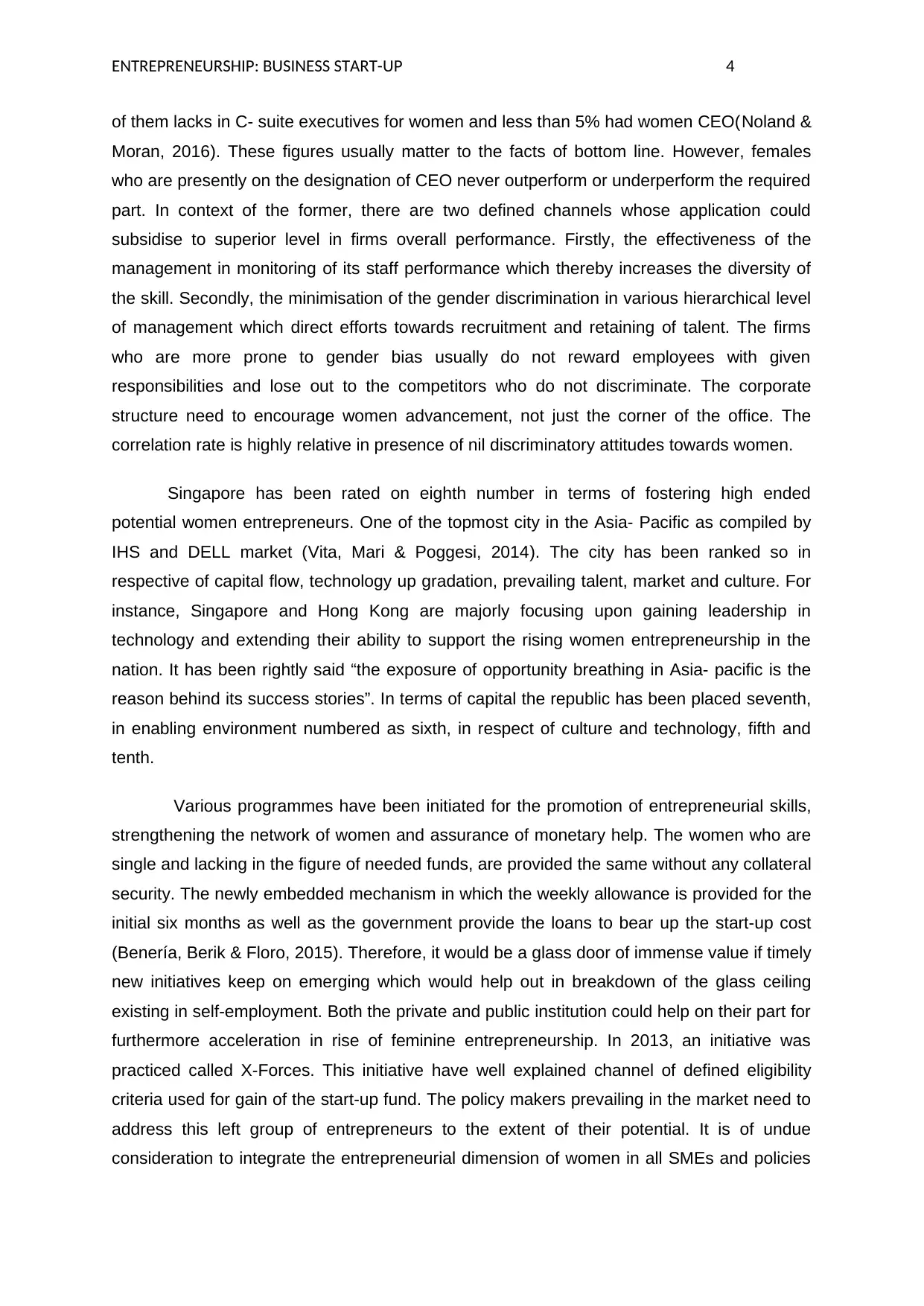
ENTREPRENEURSHIP: BUSINESS START-UP 4
of them lacks in C- suite executives for women and less than 5% had women CEO(Noland &
Moran, 2016). These figures usually matter to the facts of bottom line. However, females
who are presently on the designation of CEO never outperform or underperform the required
part. In context of the former, there are two defined channels whose application could
subsidise to superior level in firms overall performance. Firstly, the effectiveness of the
management in monitoring of its staff performance which thereby increases the diversity of
the skill. Secondly, the minimisation of the gender discrimination in various hierarchical level
of management which direct efforts towards recruitment and retaining of talent. The firms
who are more prone to gender bias usually do not reward employees with given
responsibilities and lose out to the competitors who do not discriminate. The corporate
structure need to encourage women advancement, not just the corner of the office. The
correlation rate is highly relative in presence of nil discriminatory attitudes towards women.
Singapore has been rated on eighth number in terms of fostering high ended
potential women entrepreneurs. One of the topmost city in the Asia- Pacific as compiled by
IHS and DELL market (Vita, Mari & Poggesi, 2014). The city has been ranked so in
respective of capital flow, technology up gradation, prevailing talent, market and culture. For
instance, Singapore and Hong Kong are majorly focusing upon gaining leadership in
technology and extending their ability to support the rising women entrepreneurship in the
nation. It has been rightly said “the exposure of opportunity breathing in Asia- pacific is the
reason behind its success stories”. In terms of capital the republic has been placed seventh,
in enabling environment numbered as sixth, in respect of culture and technology, fifth and
tenth.
Various programmes have been initiated for the promotion of entrepreneurial skills,
strengthening the network of women and assurance of monetary help. The women who are
single and lacking in the figure of needed funds, are provided the same without any collateral
security. The newly embedded mechanism in which the weekly allowance is provided for the
initial six months as well as the government provide the loans to bear up the start-up cost
(Benería, Berik & Floro, 2015). Therefore, it would be a glass door of immense value if timely
new initiatives keep on emerging which would help out in breakdown of the glass ceiling
existing in self-employment. Both the private and public institution could help on their part for
furthermore acceleration in rise of feminine entrepreneurship. In 2013, an initiative was
practiced called X-Forces. This initiative have well explained channel of defined eligibility
criteria used for gain of the start-up fund. The policy makers prevailing in the market need to
address this left group of entrepreneurs to the extent of their potential. It is of undue
consideration to integrate the entrepreneurial dimension of women in all SMEs and policies
of them lacks in C- suite executives for women and less than 5% had women CEO(Noland &
Moran, 2016). These figures usually matter to the facts of bottom line. However, females
who are presently on the designation of CEO never outperform or underperform the required
part. In context of the former, there are two defined channels whose application could
subsidise to superior level in firms overall performance. Firstly, the effectiveness of the
management in monitoring of its staff performance which thereby increases the diversity of
the skill. Secondly, the minimisation of the gender discrimination in various hierarchical level
of management which direct efforts towards recruitment and retaining of talent. The firms
who are more prone to gender bias usually do not reward employees with given
responsibilities and lose out to the competitors who do not discriminate. The corporate
structure need to encourage women advancement, not just the corner of the office. The
correlation rate is highly relative in presence of nil discriminatory attitudes towards women.
Singapore has been rated on eighth number in terms of fostering high ended
potential women entrepreneurs. One of the topmost city in the Asia- Pacific as compiled by
IHS and DELL market (Vita, Mari & Poggesi, 2014). The city has been ranked so in
respective of capital flow, technology up gradation, prevailing talent, market and culture. For
instance, Singapore and Hong Kong are majorly focusing upon gaining leadership in
technology and extending their ability to support the rising women entrepreneurship in the
nation. It has been rightly said “the exposure of opportunity breathing in Asia- pacific is the
reason behind its success stories”. In terms of capital the republic has been placed seventh,
in enabling environment numbered as sixth, in respect of culture and technology, fifth and
tenth.
Various programmes have been initiated for the promotion of entrepreneurial skills,
strengthening the network of women and assurance of monetary help. The women who are
single and lacking in the figure of needed funds, are provided the same without any collateral
security. The newly embedded mechanism in which the weekly allowance is provided for the
initial six months as well as the government provide the loans to bear up the start-up cost
(Benería, Berik & Floro, 2015). Therefore, it would be a glass door of immense value if timely
new initiatives keep on emerging which would help out in breakdown of the glass ceiling
existing in self-employment. Both the private and public institution could help on their part for
furthermore acceleration in rise of feminine entrepreneurship. In 2013, an initiative was
practiced called X-Forces. This initiative have well explained channel of defined eligibility
criteria used for gain of the start-up fund. The policy makers prevailing in the market need to
address this left group of entrepreneurs to the extent of their potential. It is of undue
consideration to integrate the entrepreneurial dimension of women in all SMEs and policies
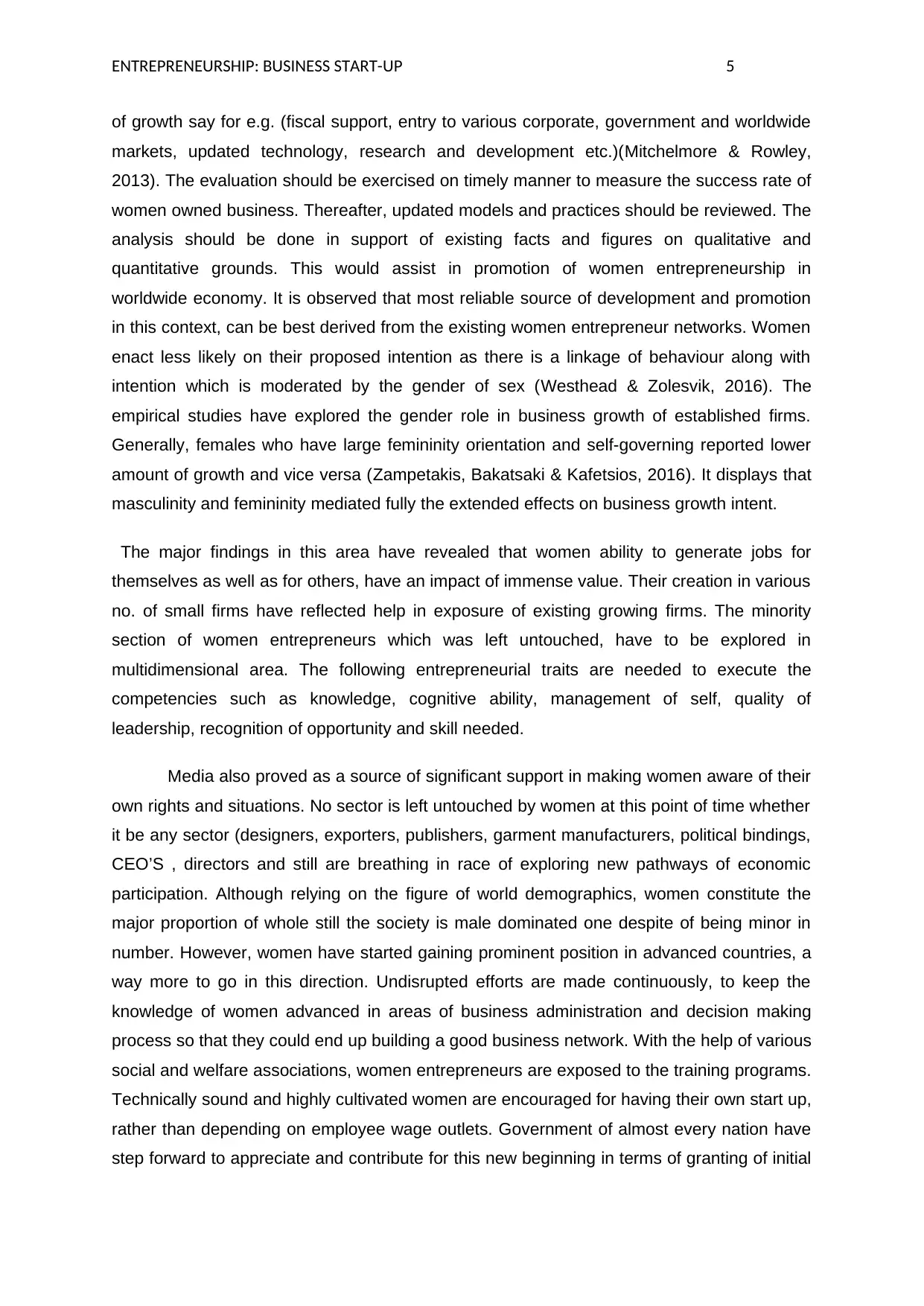
ENTREPRENEURSHIP: BUSINESS START-UP 5
of growth say for e.g. (fiscal support, entry to various corporate, government and worldwide
markets, updated technology, research and development etc.)(Mitchelmore & Rowley,
2013). The evaluation should be exercised on timely manner to measure the success rate of
women owned business. Thereafter, updated models and practices should be reviewed. The
analysis should be done in support of existing facts and figures on qualitative and
quantitative grounds. This would assist in promotion of women entrepreneurship in
worldwide economy. It is observed that most reliable source of development and promotion
in this context, can be best derived from the existing women entrepreneur networks. Women
enact less likely on their proposed intention as there is a linkage of behaviour along with
intention which is moderated by the gender of sex (Westhead & Zolesvik, 2016). The
empirical studies have explored the gender role in business growth of established firms.
Generally, females who have large femininity orientation and self-governing reported lower
amount of growth and vice versa (Zampetakis, Bakatsaki & Kafetsios, 2016). It displays that
masculinity and femininity mediated fully the extended effects on business growth intent.
The major findings in this area have revealed that women ability to generate jobs for
themselves as well as for others, have an impact of immense value. Their creation in various
no. of small firms have reflected help in exposure of existing growing firms. The minority
section of women entrepreneurs which was left untouched, have to be explored in
multidimensional area. The following entrepreneurial traits are needed to execute the
competencies such as knowledge, cognitive ability, management of self, quality of
leadership, recognition of opportunity and skill needed.
Media also proved as a source of significant support in making women aware of their
own rights and situations. No sector is left untouched by women at this point of time whether
it be any sector (designers, exporters, publishers, garment manufacturers, political bindings,
CEO’S , directors and still are breathing in race of exploring new pathways of economic
participation. Although relying on the figure of world demographics, women constitute the
major proportion of whole still the society is male dominated one despite of being minor in
number. However, women have started gaining prominent position in advanced countries, a
way more to go in this direction. Undisrupted efforts are made continuously, to keep the
knowledge of women advanced in areas of business administration and decision making
process so that they could end up building a good business network. With the help of various
social and welfare associations, women entrepreneurs are exposed to the training programs.
Technically sound and highly cultivated women are encouraged for having their own start up,
rather than depending on employee wage outlets. Government of almost every nation have
step forward to appreciate and contribute for this new beginning in terms of granting of initial
of growth say for e.g. (fiscal support, entry to various corporate, government and worldwide
markets, updated technology, research and development etc.)(Mitchelmore & Rowley,
2013). The evaluation should be exercised on timely manner to measure the success rate of
women owned business. Thereafter, updated models and practices should be reviewed. The
analysis should be done in support of existing facts and figures on qualitative and
quantitative grounds. This would assist in promotion of women entrepreneurship in
worldwide economy. It is observed that most reliable source of development and promotion
in this context, can be best derived from the existing women entrepreneur networks. Women
enact less likely on their proposed intention as there is a linkage of behaviour along with
intention which is moderated by the gender of sex (Westhead & Zolesvik, 2016). The
empirical studies have explored the gender role in business growth of established firms.
Generally, females who have large femininity orientation and self-governing reported lower
amount of growth and vice versa (Zampetakis, Bakatsaki & Kafetsios, 2016). It displays that
masculinity and femininity mediated fully the extended effects on business growth intent.
The major findings in this area have revealed that women ability to generate jobs for
themselves as well as for others, have an impact of immense value. Their creation in various
no. of small firms have reflected help in exposure of existing growing firms. The minority
section of women entrepreneurs which was left untouched, have to be explored in
multidimensional area. The following entrepreneurial traits are needed to execute the
competencies such as knowledge, cognitive ability, management of self, quality of
leadership, recognition of opportunity and skill needed.
Media also proved as a source of significant support in making women aware of their
own rights and situations. No sector is left untouched by women at this point of time whether
it be any sector (designers, exporters, publishers, garment manufacturers, political bindings,
CEO’S , directors and still are breathing in race of exploring new pathways of economic
participation. Although relying on the figure of world demographics, women constitute the
major proportion of whole still the society is male dominated one despite of being minor in
number. However, women have started gaining prominent position in advanced countries, a
way more to go in this direction. Undisrupted efforts are made continuously, to keep the
knowledge of women advanced in areas of business administration and decision making
process so that they could end up building a good business network. With the help of various
social and welfare associations, women entrepreneurs are exposed to the training programs.
Technically sound and highly cultivated women are encouraged for having their own start up,
rather than depending on employee wage outlets. Government of almost every nation have
step forward to appreciate and contribute for this new beginning in terms of granting of initial
⊘ This is a preview!⊘
Do you want full access?
Subscribe today to unlock all pages.

Trusted by 1+ million students worldwide
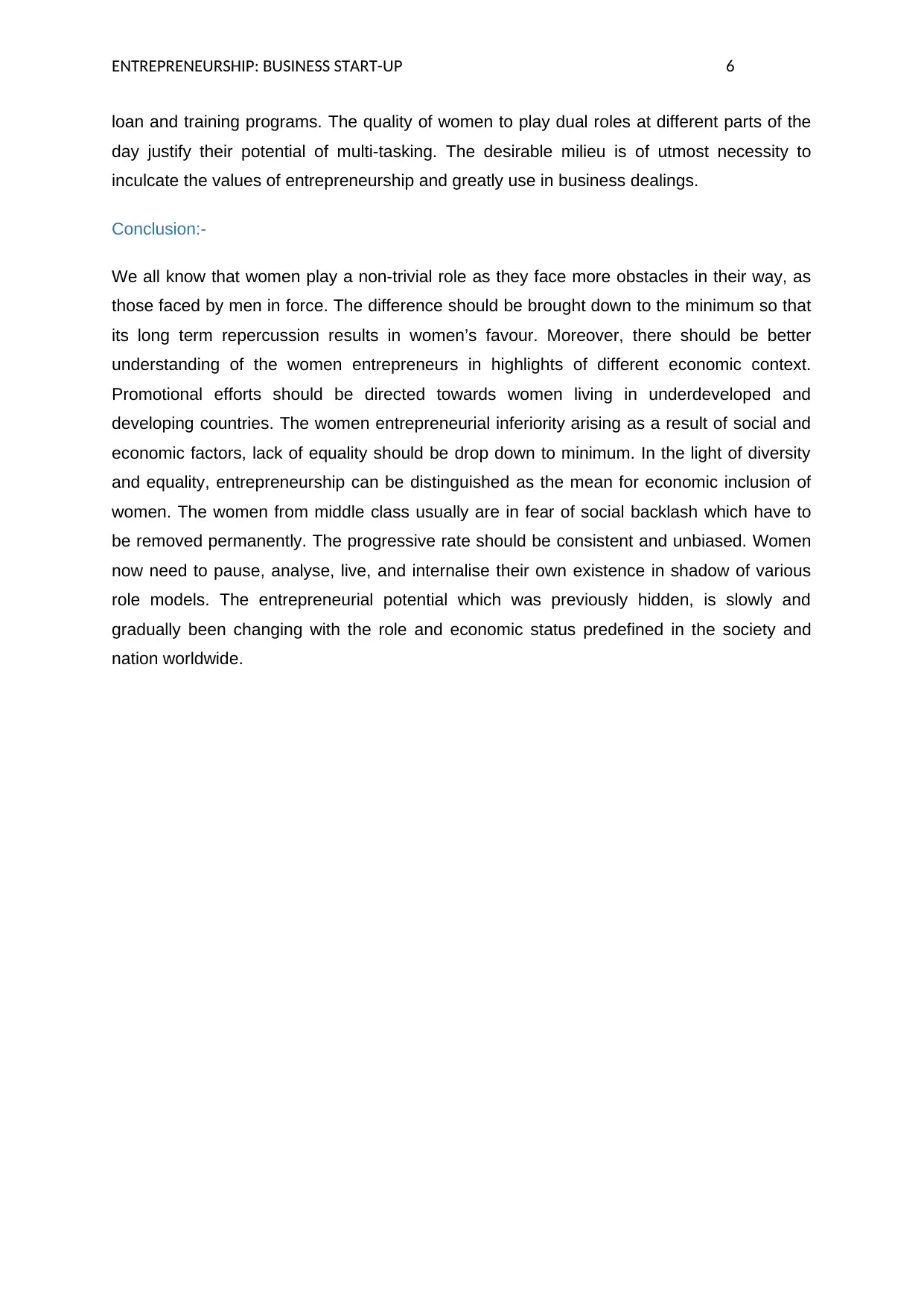
ENTREPRENEURSHIP: BUSINESS START-UP 6
loan and training programs. The quality of women to play dual roles at different parts of the
day justify their potential of multi-tasking. The desirable milieu is of utmost necessity to
inculcate the values of entrepreneurship and greatly use in business dealings.
Conclusion:-
We all know that women play a non-trivial role as they face more obstacles in their way, as
those faced by men in force. The difference should be brought down to the minimum so that
its long term repercussion results in women’s favour. Moreover, there should be better
understanding of the women entrepreneurs in highlights of different economic context.
Promotional efforts should be directed towards women living in underdeveloped and
developing countries. The women entrepreneurial inferiority arising as a result of social and
economic factors, lack of equality should be drop down to minimum. In the light of diversity
and equality, entrepreneurship can be distinguished as the mean for economic inclusion of
women. The women from middle class usually are in fear of social backlash which have to
be removed permanently. The progressive rate should be consistent and unbiased. Women
now need to pause, analyse, live, and internalise their own existence in shadow of various
role models. The entrepreneurial potential which was previously hidden, is slowly and
gradually been changing with the role and economic status predefined in the society and
nation worldwide.
loan and training programs. The quality of women to play dual roles at different parts of the
day justify their potential of multi-tasking. The desirable milieu is of utmost necessity to
inculcate the values of entrepreneurship and greatly use in business dealings.
Conclusion:-
We all know that women play a non-trivial role as they face more obstacles in their way, as
those faced by men in force. The difference should be brought down to the minimum so that
its long term repercussion results in women’s favour. Moreover, there should be better
understanding of the women entrepreneurs in highlights of different economic context.
Promotional efforts should be directed towards women living in underdeveloped and
developing countries. The women entrepreneurial inferiority arising as a result of social and
economic factors, lack of equality should be drop down to minimum. In the light of diversity
and equality, entrepreneurship can be distinguished as the mean for economic inclusion of
women. The women from middle class usually are in fear of social backlash which have to
be removed permanently. The progressive rate should be consistent and unbiased. Women
now need to pause, analyse, live, and internalise their own existence in shadow of various
role models. The entrepreneurial potential which was previously hidden, is slowly and
gradually been changing with the role and economic status predefined in the society and
nation worldwide.
Paraphrase This Document
Need a fresh take? Get an instant paraphrase of this document with our AI Paraphraser
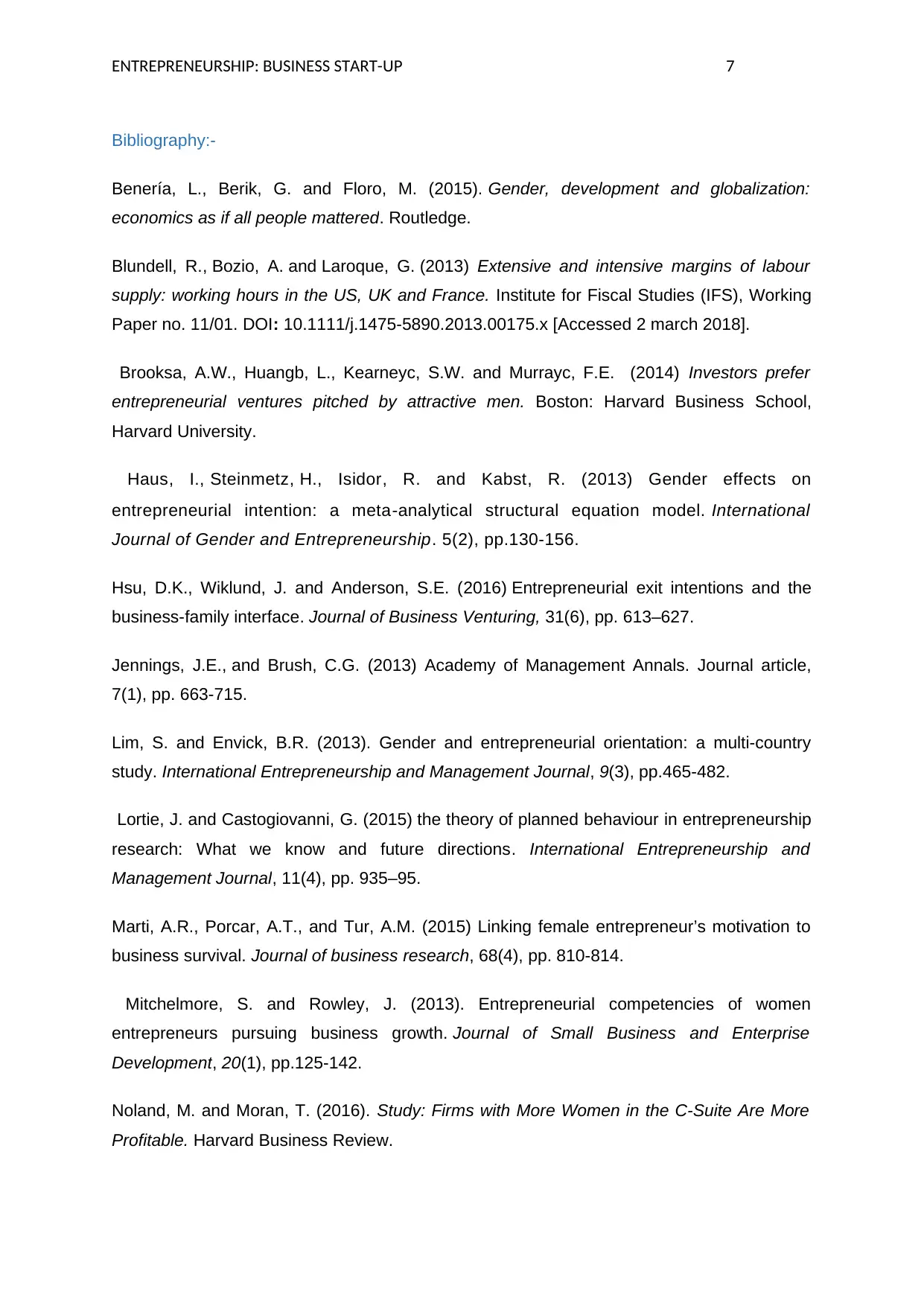
ENTREPRENEURSHIP: BUSINESS START-UP 7
Bibliography:-
Benería, L., Berik, G. and Floro, M. (2015). Gender, development and globalization:
economics as if all people mattered. Routledge.
Blundell, R., Bozio, A. and Laroque, G. (2013) Extensive and intensive margins of labour
supply: working hours in the US, UK and France. Institute for Fiscal Studies (IFS), Working
Paper no. 11/01. DOI: 10.1111/j.1475-5890.2013.00175.x [Accessed 2 march 2018].
Brooksa, A.W., Huangb, L., Kearneyc, S.W. and Murrayc, F.E. (2014) Investors prefer
entrepreneurial ventures pitched by attractive men. Boston: Harvard Business School,
Harvard University.
Haus, I., Steinmetz, H., Isidor, R. and Kabst, R. (2013) Gender effects on
entrepreneurial intention: a meta‐analytical structural equation model. International
Journal of Gender and Entrepreneurship. 5(2), pp.130-156.
Hsu, D.K., Wiklund, J. and Anderson, S.E. (2016) Entrepreneurial exit intentions and the
business-family interface. Journal of Business Venturing, 31(6), pp. 613–627.
Jennings, J.E., and Brush, C.G. (2013) Academy of Management Annals. Journal article,
7(1), pp. 663-715.
Lim, S. and Envick, B.R. (2013). Gender and entrepreneurial orientation: a multi-country
study. International Entrepreneurship and Management Journal, 9(3), pp.465-482.
Lortie, J. and Castogiovanni, G. (2015) the theory of planned behaviour in entrepreneurship
research: What we know and future directions. International Entrepreneurship and
Management Journal, 11(4), pp. 935–95.
Marti, A.R., Porcar, A.T., and Tur, A.M. (2015) Linking female entrepreneur’s motivation to
business survival. Journal of business research, 68(4), pp. 810-814.
Mitchelmore, S. and Rowley, J. (2013). Entrepreneurial competencies of women
entrepreneurs pursuing business growth. Journal of Small Business and Enterprise
Development, 20(1), pp.125-142.
Noland, M. and Moran, T. (2016). Study: Firms with More Women in the C-Suite Are More
Profitable. Harvard Business Review.
Bibliography:-
Benería, L., Berik, G. and Floro, M. (2015). Gender, development and globalization:
economics as if all people mattered. Routledge.
Blundell, R., Bozio, A. and Laroque, G. (2013) Extensive and intensive margins of labour
supply: working hours in the US, UK and France. Institute for Fiscal Studies (IFS), Working
Paper no. 11/01. DOI: 10.1111/j.1475-5890.2013.00175.x [Accessed 2 march 2018].
Brooksa, A.W., Huangb, L., Kearneyc, S.W. and Murrayc, F.E. (2014) Investors prefer
entrepreneurial ventures pitched by attractive men. Boston: Harvard Business School,
Harvard University.
Haus, I., Steinmetz, H., Isidor, R. and Kabst, R. (2013) Gender effects on
entrepreneurial intention: a meta‐analytical structural equation model. International
Journal of Gender and Entrepreneurship. 5(2), pp.130-156.
Hsu, D.K., Wiklund, J. and Anderson, S.E. (2016) Entrepreneurial exit intentions and the
business-family interface. Journal of Business Venturing, 31(6), pp. 613–627.
Jennings, J.E., and Brush, C.G. (2013) Academy of Management Annals. Journal article,
7(1), pp. 663-715.
Lim, S. and Envick, B.R. (2013). Gender and entrepreneurial orientation: a multi-country
study. International Entrepreneurship and Management Journal, 9(3), pp.465-482.
Lortie, J. and Castogiovanni, G. (2015) the theory of planned behaviour in entrepreneurship
research: What we know and future directions. International Entrepreneurship and
Management Journal, 11(4), pp. 935–95.
Marti, A.R., Porcar, A.T., and Tur, A.M. (2015) Linking female entrepreneur’s motivation to
business survival. Journal of business research, 68(4), pp. 810-814.
Mitchelmore, S. and Rowley, J. (2013). Entrepreneurial competencies of women
entrepreneurs pursuing business growth. Journal of Small Business and Enterprise
Development, 20(1), pp.125-142.
Noland, M. and Moran, T. (2016). Study: Firms with More Women in the C-Suite Are More
Profitable. Harvard Business Review.
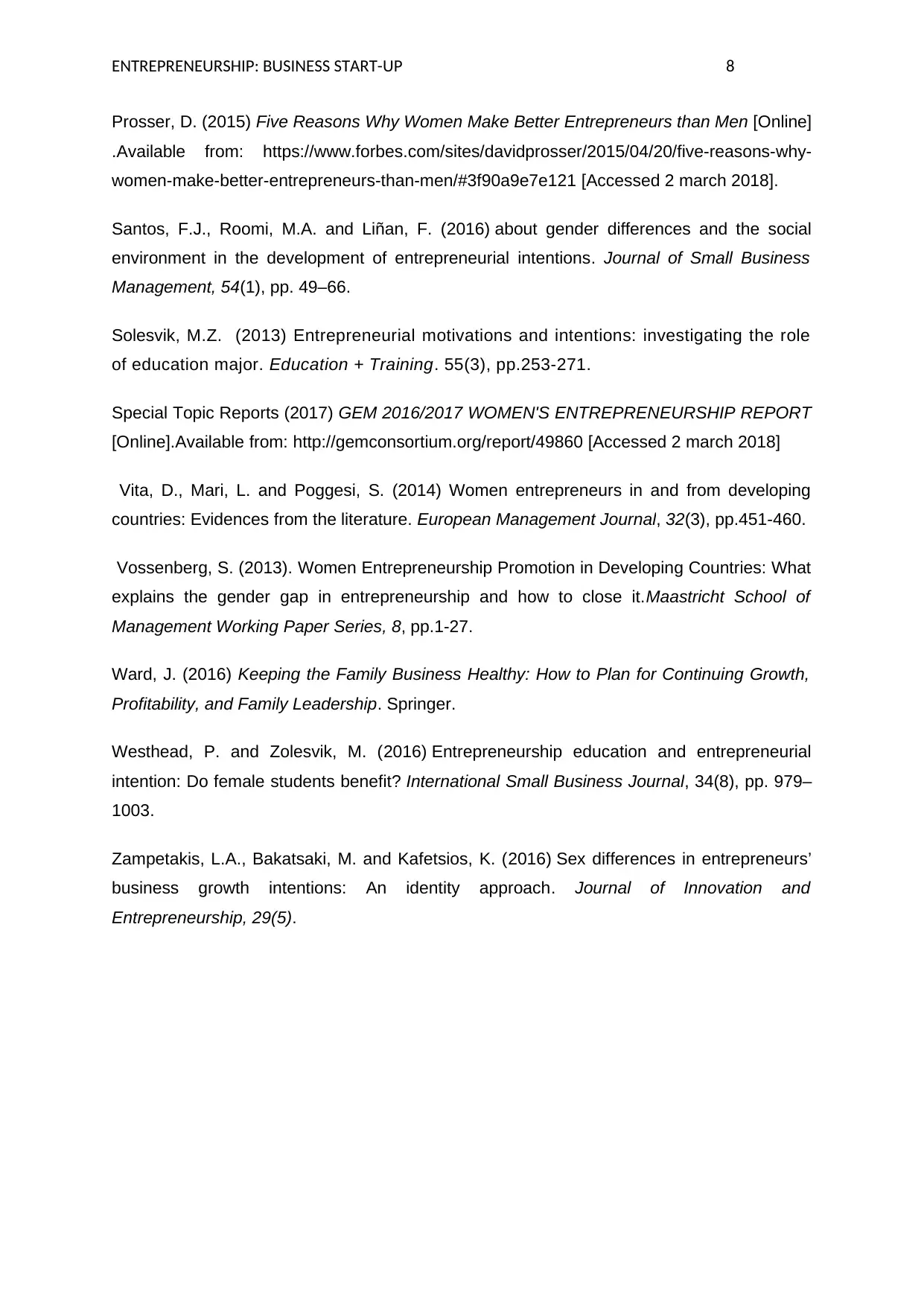
ENTREPRENEURSHIP: BUSINESS START-UP 8
Prosser, D. (2015) Five Reasons Why Women Make Better Entrepreneurs than Men [Online]
.Available from: https://www.forbes.com/sites/davidprosser/2015/04/20/five-reasons-why-
women-make-better-entrepreneurs-than-men/#3f90a9e7e121 [Accessed 2 march 2018].
Santos, F.J., Roomi, M.A. and Liñan, F. (2016) about gender differences and the social
environment in the development of entrepreneurial intentions. Journal of Small Business
Management, 54(1), pp. 49–66.
Solesvik, M.Z. (2013) Entrepreneurial motivations and intentions: investigating the role
of education major. Education + Training. 55(3), pp.253-271.
Special Topic Reports (2017) GEM 2016/2017 WOMEN'S ENTREPRENEURSHIP REPORT
[Online].Available from: http://gemconsortium.org/report/49860 [Accessed 2 march 2018]
Vita, D., Mari, L. and Poggesi, S. (2014) Women entrepreneurs in and from developing
countries: Evidences from the literature. European Management Journal, 32(3), pp.451-460.
Vossenberg, S. (2013). Women Entrepreneurship Promotion in Developing Countries: What
explains the gender gap in entrepreneurship and how to close it.Maastricht School of
Management Working Paper Series, 8, pp.1-27.
Ward, J. (2016) Keeping the Family Business Healthy: How to Plan for Continuing Growth,
Profitability, and Family Leadership. Springer.
Westhead, P. and Zolesvik, M. (2016) Entrepreneurship education and entrepreneurial
intention: Do female students benefit? International Small Business Journal, 34(8), pp. 979–
1003.
Zampetakis, L.A., Bakatsaki, M. and Kafetsios, K. (2016) Sex differences in entrepreneurs’
business growth intentions: An identity approach. Journal of Innovation and
Entrepreneurship, 29(5).
Prosser, D. (2015) Five Reasons Why Women Make Better Entrepreneurs than Men [Online]
.Available from: https://www.forbes.com/sites/davidprosser/2015/04/20/five-reasons-why-
women-make-better-entrepreneurs-than-men/#3f90a9e7e121 [Accessed 2 march 2018].
Santos, F.J., Roomi, M.A. and Liñan, F. (2016) about gender differences and the social
environment in the development of entrepreneurial intentions. Journal of Small Business
Management, 54(1), pp. 49–66.
Solesvik, M.Z. (2013) Entrepreneurial motivations and intentions: investigating the role
of education major. Education + Training. 55(3), pp.253-271.
Special Topic Reports (2017) GEM 2016/2017 WOMEN'S ENTREPRENEURSHIP REPORT
[Online].Available from: http://gemconsortium.org/report/49860 [Accessed 2 march 2018]
Vita, D., Mari, L. and Poggesi, S. (2014) Women entrepreneurs in and from developing
countries: Evidences from the literature. European Management Journal, 32(3), pp.451-460.
Vossenberg, S. (2013). Women Entrepreneurship Promotion in Developing Countries: What
explains the gender gap in entrepreneurship and how to close it.Maastricht School of
Management Working Paper Series, 8, pp.1-27.
Ward, J. (2016) Keeping the Family Business Healthy: How to Plan for Continuing Growth,
Profitability, and Family Leadership. Springer.
Westhead, P. and Zolesvik, M. (2016) Entrepreneurship education and entrepreneurial
intention: Do female students benefit? International Small Business Journal, 34(8), pp. 979–
1003.
Zampetakis, L.A., Bakatsaki, M. and Kafetsios, K. (2016) Sex differences in entrepreneurs’
business growth intentions: An identity approach. Journal of Innovation and
Entrepreneurship, 29(5).
⊘ This is a preview!⊘
Do you want full access?
Subscribe today to unlock all pages.

Trusted by 1+ million students worldwide

ENTREPRENEURSHIP: BUSINESS START-UP 9
1 out of 10
Related Documents
Your All-in-One AI-Powered Toolkit for Academic Success.
+13062052269
info@desklib.com
Available 24*7 on WhatsApp / Email
![[object Object]](/_next/static/media/star-bottom.7253800d.svg)
Unlock your academic potential
Copyright © 2020–2025 A2Z Services. All Rights Reserved. Developed and managed by ZUCOL.





